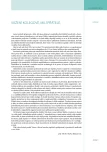Aggressive prostate cancer in patients with low PSA
Authors:
Michal Grepl; Milan Král; Eva Burešová; Vladimír Študent
Authors‘ workplace:
Urologická klinika LF UP a FN, Olomouc
Published in:
Ces Urol 2010; 14(1): 48-54
Category:
Original article
Overview
Aim:
To investigate prevalence and characteristics of the prostate cancer in men with total PSA < 4 ng/ml.
Material and methods:
We evaluated 731 men with consecutive multiplicated prostate biopsies. Indication criteria for biopsy were elevation of age-specific PSA, increasing PSA velocity or suspicious digital rectal examination.
Results:
Together 202 patients underwent prostate biopsy with PSA < 4 ng/ml. In the group with low PSA the prevalence of prostate cancer was 18,8% and in the group with PSA > 4 ng/ml the prevalence was 30.7% (p < 0.001). Acinar adenocarcinoma was described in all positive samples. After biopsy 57.8% of carcinomas were T1c stage, 36.8% were T2a–b and 5.4% were suspicious for T3a–b. Gleason score (GS) 2+3 or 3+3 were described in 65.8%, GS 7 in 26.3% and GS 8 and more in 7.9% of positive samples. In men after radical prostatectomy there were 75.8% of localized diseases and 24.2% of advanced diseases. In 9.7% we have found metastatic affection of lymph nodes or axial skelet. Upstage was nearly non-significant (p = 0.06). In these definitive specimens GS 6 was described in 32.2%, GS 7 in 50% and GS > 8 in 27.8%. Impairment of Gleason score was significant (p = 0.005).
Conclusion:
In the group of patients with prostate cancer and PSA < 4 ng/ml only 23.6% met the criteria for insignificant disease. In 76.4% cases we found potentially aggressive carcinomas and nearly quarter (24.2%) of cancers was advanced or metastatic.
Key words:
prostate cancer, prostate specific antigen, PSA.
Sources
1. Myrtle J, Ivor L. Measurement of PSA in serum by two immunometric methods (Hybritech Tandem-R/Tandem-E PSA). In Catalona WJ (ed): Clinical Aspects of Prostate Cancer. New York: Elsevier 1989; 161–171.
2. Thompson IM, Pauler DK, Goodman PJ, et al. Prevalence of prostate cancer among men with a prostate-specific antigen level < or = 4.0 ng per milliliter. N Engl J Med 2004; 350 : 2239–2246.
3. Schröder FH, Bangma CH. The European Randomized Study of Screening for Prostate Cancer (ERSPC). Br J Urol 1997; 79(Suppl 1): 68–71.
4. Schröder FH, Kranse R, Rietbergen J, et al. The European Randomized Study of Screening for Prostate Cancer (ERSPC): An update. Members of the ERSPC, Section Rotterdam. Eur Urol 1999; 35 : 539–543.
5. Catalona WJ, Hudson MA, Scardino PT, et al. Selection of optimal prostate specific antigen cutoffs for early detection of prostate cancer: receiver operating characteristic curves. J Urol 1994; 152 : 2037–2042.
6. Durkan GC, Sheikh N, Johnson P, Hildreth AJ, Greene DR. Improving prostate cancer detection with an extended-core transrectal ultrasonography-guided prostate biopsy protocol. BJU International 2002; 89(1): 33–39.
7. Van den Bergh R, Roemeling S, Roobol M, Roobol W, Schröder F, Bangma C. Prospective Validation of Active Surveillance in Prostate Cancer: The PRIAS Study. European Urology Urology 2009; 52(6): 1560–1563.
8. Patel MI, DeConcini DT, Lopez-Corona E, et al. An analysis of men with clinically localized prostate cancer who deferred definitive therapy. The Journal of Urology 2004; 171(4): 1520–1524.
9. Soloway MS, Soloway CT, Williams S, Ayyathurai R, Kava B, Manoharan M. Active surveillance; a reasonable management alternative for patients with prostate cancer: the Miami experience. BJU International 2008; 101(2): 165–169.
10. Bastian P, Carter B, Bjartell A, et al. Insignificant Prostate Cancer and Active Surveillance: From Definition to Clinical Implications. European Urology 2009; 55(6): 1321–1332.
11. Schröder FH, Hugosson J, Roobol MJ, et al. Screening and Prostate-Cancer Mortality in a Randomized European Study. N Engl J Med 2009; 360 : 1320–1328.
12. Schröder FH. Review of diagnostic markers for prostate cancer. Recent Results Cancer Res 2009; 181 : 173–182.
13. Bonet M, Merglen A, Fioretta G, Rapiti E, Neyroud-Caspar I, Zanetti R, Miralbell R, Bouchardy C. Characteristics and outcome of prostate cancer with PSA < 4 ng/ml at diagnosis: a population-based study. Clin Transl Oncol 2009; 11(5): 312–317.
14. Kolombo I, Poršová M, Zemanová I, et al. Prostatický specifický antigen (PSA) a digitální rektální vyšetření (DRE) v diagnostice karcinomu prostaty. Urologie pro Praxi 2008; 9(2): 83–88.
15. Študent V, Grepl M, Král M, Hartmann I. Má vyšetření PSA stále význam při vyhledávání karcinomu prostaty? Urologie pro Praxi 2006; 5 : 214–218.
16. Král M, Študent V, Hrabec M. Predikční nomogramy u karcinomu prostaty. Urologie pro Praxi, 2008; 1.
17. Král M, Študent V, Hrabec M. Nomogram predikce up-gradingu Gleasonova skóre v biopsii prostaty. Česká urologie 2007; 11.
Labels
Paediatric urologist Nephrology UrologyArticle was published in
Czech Urology

2010 Issue 1
Most read in this issue
- Aggressive prostate cancer in patients with low PSA
- Anatomical implications of sex reassignment surgery in male-to-female transsexualism and follow-up study
- Laparoscopic nephropexis – technique with three non-absorbable stitches
- Prostate cancer incidence, diagnostic and treatment in HIV-positive patients
